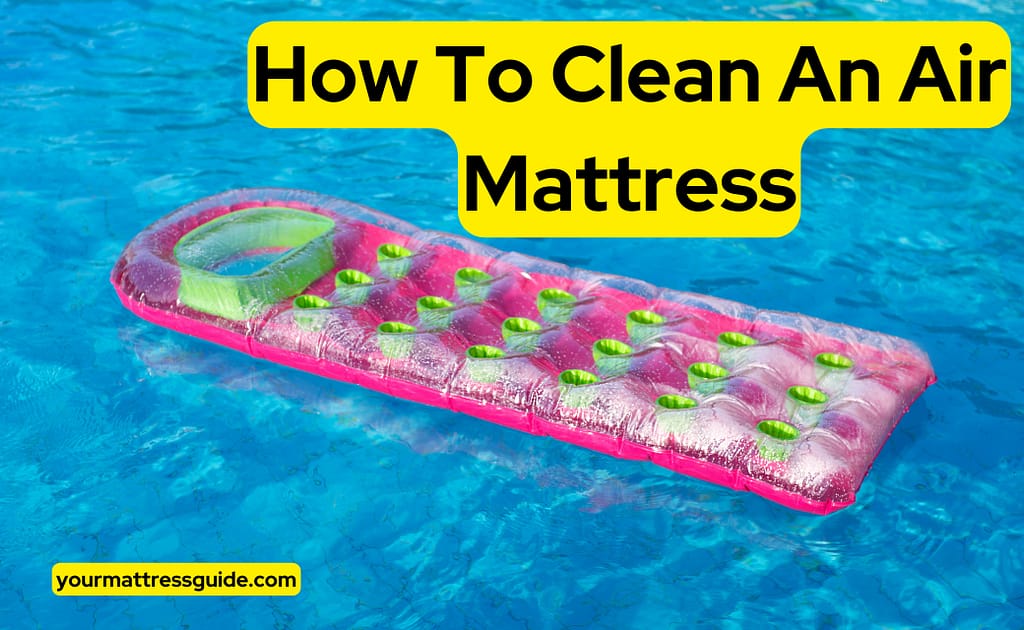Air mattresses are one of the most popular and convenient sleeping solutions you can find. They offer comfort beyond level, a night’s sleep that’s hard to miss. However, the prime of this product lies in its maintenance and how you use it. So, if you don’t know how to clean an air mattress, you’re in luck today.
Understanding proper hygiene and regular cleaning rituals can help you withstand or even prolong the lifespan of your mattress. We know how much it sounds like a hassle and no one is really up to the challenge but do you see yourself sleeping on a dirty mattress after a long day of work? Yikes, even the thought of it gives us the creeps. So, why not learn a few basics?
In today’s blog, we will go into the basics of cleaning and give you some useful insights, tips, and steps that you can manage into action without worry!

How To Clean An Air Mattress, Why Do You Need To Clean Your Air Mattress?
If you’re someone who has never cleaned their mattress before then wondering about regular cleaning may come as a surprise to you. It’s natural to not worry about it but cleaning is essential no matter how long it’s been. Especially for an air mattress that can get soil from contaminants quickly.
Some important parts of an air mattress that require cleansing are the surface, pump, and seams. These areas are more prone to getting dirty and soiled compared to any other place.
Moreover, whenever you have guests over, every time someone lays on it they leave their dead skin cells and sweat on the surface that gets mixed with the mattress’s skin. Finally, storing the mattress in an attic or cellar may allow mold and mildew to form.
All of these impurities contribute to making your mattress stink over time. Sounds gross no? That’s why we all need to learn how to clean an air mattress.
There are two types of cleaning methods when it comes to air mattresses- namely standard cleaning and deeper cleaning for stubborn stains and odors. Have questions about bed bugs and air mattresses? Find out can bed bugs get on a air mattress and learn preventive measures.
Difference Between Standard Cleaning vs. Deep Cleaning Air Mattresses
Both these procedures play a vital role in keeping your air mattress clean and tidy. However, they both cater to different areas of cleanliness. Here’s a small breakdown of how it goes:
How To Clean An Air Mattress Standard Cleaning:
- Frequency: Weekly or biweekly, depending on consumption.
- Focus: Provides basic hygiene by removing surface debris, dust, and pet hair.
Methods:
- Wipe the surface with a moist towel and a mild detergent solution.
- Vacuum the surface to remove dust and debris.
- Clean the pump’s exterior using a moist cloth and disinfectant solution.
- Gently clean seams with a gentle toothbrush and light detergent.
Benefits:
- Reduces dust and allergy buildup.
- Keeps the surface clean and free of apparent dirt.
- Increases the longevity of the air mattress by preventing minor wear and tear.
Limitations:
- Ineffective for removing deep stains or odors.
- May not be able to efficiently reach crevices and seams.
Deep Cleaning:
- Frequency: Monthly or as needed, according to usage and the appearance of stains or odors.
- Focus: Removes deep-seated filth, grime, stains, and odors.
Methods for stain removal include targeted solutions for specific types of stains (e.g., blood, food, ink).
- Use baking soda, vinegar, or enzyme detergents to neutralize odors.
- Use cotton pads and a vacuum cleaner to thoroughly clean the seams and air intake.
- Using disinfection treatments to target specific regions, such as the valve or pump filter.
Benefits:
- Restores the air mattress’s original appearance and feel.
- Removes unpleasant odors and inhibits mold growth.
- Improves both cleanliness and sleep quality.
Limitations:
- Requires more time and effort than regular cleaning.
- Specific cleaning products and techniques may be used.
How to Set Up Your Air Mattress for Cleaning?
The first and most crucial step of the process is pre-cleanup preparations. It can happen in any scenario, such as you’re having guests over or your guests just left. Or simply because you need the hygiene in your life for yourself. Whatever the case, you should know how to prepare your mattress for cleaning before getting into the real deal.
- Disconnect it from the electric source.
Most current air mattresses are filled with an electric pump powered by a battery or an electrical outlet. Before washing your mattress, unhook it from any electrical sources and move it away from any adjacent outlets. If the pump is removable, remove it from the bed to improve mobility while cleaning your air mattress.
If an air mattress has a built-in pump, use caution to keep liquid from destroying the batteries.
- Remove The Sheets:
Next, remove any bed linens, blankets, or covers from the air mattress. We recommend placing these in the washer as you clean the mattress.
Note: If you leave your air mattress setup at all times, you should wash the bedding no less than once every few weeks. Because your air mattress is on the ground, dirt, dust, and other debris can easily collect within the blankets over time.
- Vacuum It Thoroughly:
Lastly, before you go in with your cleaning solution, make sure to thoroughly vacuum your mattress to remove any remaining debris or dirt particles. While doing this step, we advise keeping your mattress inflated. You could find it difficult to clean in between the wrinkles and folds if you deflate the bed.
Make sure to cover each inch of the top material of your air bed as you carefully run the hose connection down it to vacuum it. Proceed to vacuum the mattress’s sides after that, and then turn it over to vacuum the bottom.
How To Clean An Air Mattress?
While a wide variety of textiles and plastics are utilized in the production of air mattresses, the majority of them combine materials such as rubber compounds, polyvinyl chloride (PVC), and polyurethane plastics (PU).
On more premium airbeds, you can even find velvet mattress tops and antibacterial velour (more on this below).
When cleaning your air mattresses, it is recommended to use light or gentle cleaning solutions due to the variations in material. By doing this, the likelihood of surfaces deteriorating and future holes and/or perforations will be decreased.
Step 1: For Dirt Or Dust:
It’s nearly a given that these air mattresses are being used on a floor or in a tent, just like most others. And filth and dust gathering are simply inevitable for this reason alone. So, it’s crucial to remove any loose material and trapped dust with a vacuum before using water and cleaning supplies.
To begin, inflate the mattress to the point when the pressure evens out the surfaces and releases wrinkles.
If you don’t have access to a strong vacuum, a portable device will still function well to clear trapped particles. Owners can avoid possibly embedding loose debris or dust in soft fibers or non-woven textile surfaces by using a stronger vacuum.
Unfortunately, scrubbing dirt forces particles deeper into the fabric, making it more difficult to get rid of stains and other debris.
Step 2: Removing Smell:
You have likely been keeping your air mattress with moisture if it has begun to smell musty or dirty. In this instance, search for indications of mold or mildew growth.
If any visible germs are discovered, you should postpone this odor-reduction procedure until after drying.
Owners should cover the mattress with a coating of baking soda if an inspection reveals no development. Although it’s not necessary to completely cover the airbed, employing insufficient baking soda may leave smells behind.
Before vacuuming it clean, let the baking soda stay for three to five minutes.
Step 3: Cleaning With Solution:
- The most popular combinations are rubbing alcohol diluted in warm water (excellent for mildew); mild soap and warm water; or a vinegar-to-water ratio of half-and-half (ideal for mold).
- You may also buy branded disinfectants to clean your mattress, but for product recommendations, it’s better to refer to your user manual or get in touch with the maker of your airbeds.
- Once the ideal cleaning solution for the material of your mattress has been determined, it is advised to finish the operation in a warm, dry, and well-lit space. In addition to shortening drying times, this will aid in preventing the growth of extra mold or mildew.
- Clean all flat rubber or plastic surfaces with a clean cloth dipped in your mixture. Cleaning stains in these places vigorously shouldn’t intimidate you because air mattresses are made to tolerate more abuse than usual.
- However, it’s crucial to handle velvet or velour surfaces with a little extra delicacy. The easiest way to remove stains from fabric surfaces is to work from the outside inward, using small circular strokes.
PRO TIP: Steer clear of over-wetting your clothes. The ideal approach is to squeeze out as much liquid as you can before cleaning a surface. By doing this, moisture buildup and the eventual growth of mold and other microbes are avoided. Planning to host guests on an air mattress? Understand the limitations and find out how much weight can an air mattress hold to ensure a comfortable stay.
Step 4: Drying An Air Mattress:
The easiest way to dry your mattress is to go outside on a warm, sunny day. The climate outside and moisture dispersion are unparalleled, even if prolonged exposure to UV radiation may cause materials to deteriorate.
The next best thing to leaving an air mattress outside, depending on the weather or where you live, is to put it next to a dehumidifier so that it can dry. Before putting your mattress away, it is crucial to make sure it is totally dry.

Useful Tips On How To Prevent Molds On Mattresses
After cleaning your mattress and allowing it to dry completely so it can be stored, you should consider how to stop mold and mildew from growing in the future.
Since damp and gloomy conditions are ideal for the growth of bacteria and fungi, it’s critical to store and maintain your air mattress outside of these spaces.
Easy ventilation upgrades, like dehumidifiers, are ideal for facilitating air circulation in compact storage spaces. This will assist in dissipating any moisture left over from cleaning and reduce the likelihood of humidity building up.
A great way to avoid moisture in storage areas is to install vapor barriers, charcoal, or desiccant. While desiccant and charcoal materials absorb and trap odors or humidity already existing in a room, vapor barriers can be put to basement walls to prevent humid air from entering.
Store your air mattress in places like linen closets if at all possible. The humidity is usually low and the temperature is constant. The best course of action for extending the life of your airbed is this. Also, check out our article on How To Make An Air Mattress More Comfortable.
Conclusion:
You should have a decent understanding of how to clean an air mattress by this point. By using the above-mentioned techniques, homes can effectively remove odors or stains from their air mattress. Nevertheless, if you’re still skeptical about doing this yourself, you can always opt for professional help depending on your budget.
FAQs
How To Get Rid Of Urine From A Mattress?
Cover the whole surface of the air mattress with a thick layer of baking soda. To absorb the odor, let it sit for a few hours or overnight. It will help get rid of the stain and odor of urine.
Can you put air mattresses in the washing machine?
You should never use a washing machine to clean an air mattress. Investing in an air mattress with a unique antimicrobial covering that helps stop the growth of mold, mildew, and bacteria that cause odors, is a terrific way to offer yourself an extra layer of defense against the filth.
What not to do with an air mattress?
Never use an air mattress in water. Keep your air mattress away from fire. Do not use flammable substances (like aerosol tire repair products) with your air mattress. The mattress may ignite or explode.


